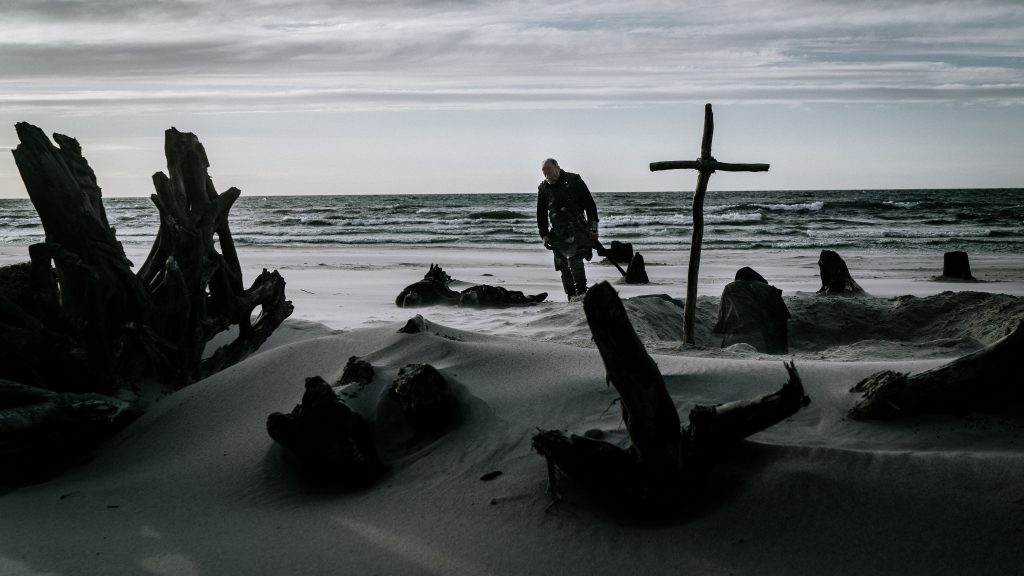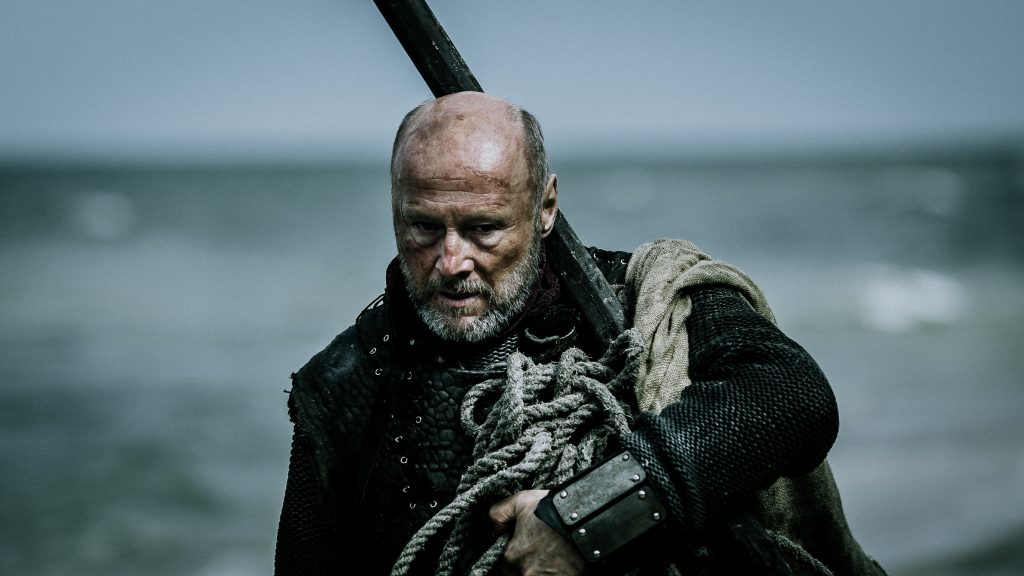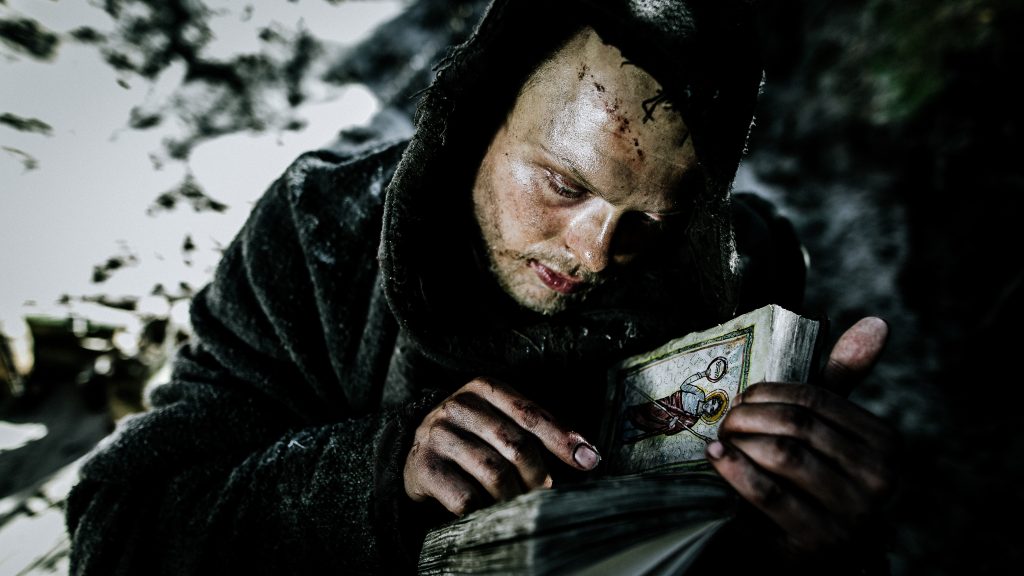NEWS
07/10/2017
Enlightenment Through Hell
A determined missionary on the last pagan island. What will prove stronger? New faith or old traditions? Bartosz Konopka is wrapping up shooting for his latest film “Krew Boga” – a story about faith and doubt, silence and dialogue. “Everything about this project is extreme”, claims the director.

Krew Boga, dir. Bartosz Konopka / fot. Bartosz Mrozowski
Jakub Demieńczuk: Making a medieval costume film in today’s Poland seems like quite a daring choice. It’s a very non-commercial undertaking.
Bartosz Konopka: Of course, it’s an art house film, but I hope that it will reach a wider audience. Except that we weren’t aiming for a flashy spectacle – obviously, we didn’t have the means, and I’d never even attempt anything of that sort. This is an intimate story that defies the audience’s expectations. We call It historical fiction. We used to refer to it as historical fantasy, but that makes people think of dragons, “Game of Thrones”, or “Willow” – and that’s not it either. “Krew Boga” is a parable. It doesn’t take place in a particular time or place. It’s not a historical film.
Then why make it a costume one?
It all started with the fact that after “Fear of Falling”, I really didn’t want to make another contemporary psychological drama, and was craving a return to the essence of cinema: telling stories using image and sound. I wanted to make something that would speak to people on a more immediate, emotional level. Tell a tale that draws you in even though you’re not exactly sure where it will take you. And then there were also my recent ruminations. I got interested in muteness as a way to withdraw from the everyday hustle, to escape the ubiquitous babble. When I went to the New Horizons festival in Wrocław with “Fear of Flying”, I saw Nicolas Winding Refn’s “Valhalla Rising”. Refn proved that by moving the plot into medieval times, you can pair a quest for spirituality and incredible inner sensitivity with brutality, cruelty, and uncertainty as to what each new day will bring. I really like that in film. It’s like a magnifying glass that allows us to examine ourselves here and now. Costume films are also about parallels, about finding the contemporary equivalent, and learning something new about ourselves through this juxtaposition.

Krew Boga, dir. Bartosz Konopka / fot. Bartosz Mrozowski
Refn’s protagonist was a Viking. In “Krew Boga” we have a missionary, and it is probably no coincidence that he is named after Wilibrord of Utrecht, the man who Christianized pagans in the Netherlands.
When I was looking for my topic, I thought about the first missionaries, because there are no films about those times. There’s no movie about Saint Patrick, Saint Adalbert, the Saints Cyril and Methodius. But I’ve consulted historians and arrived at the conclusion that it would be pointless to make a film about a historical figure. Because aside from being a complex, multi-layered narrative, the movie would also have to be a hagiography, and I wanted to avoid that. Finally, Professor Jerzy Strzelczyk agreed with me that I should make a sort of compilation, which would give me license to talk about certain mechanisms. And that’s what interested me the most. I really wanted this story to be universal. I wanted to boil it down to the most basic of relationships. In “Krew Boga”, we have two characters – they’re not father and son, like in “Fear of Flying”, but they do share a connection. The younger one, The Nameless One, saves the life of the missionary Wilibrord, who has lost all his companions. The two of them go to the last pagan island. Wilibrord wants to find the pagans and christen them, thus saving their lives, because otherwise they will be slaughtered by the king’s army. However, the mission proves to be a difficult one. The pagans don’t want to adopt a new faith. Wilibrord attempts to manipulate them, he challenges the pagan priest to a trial by fire to take his place. He believes that the end justifies the means, that the ideology he champions gives him license to cut some corners. Blinded by the ideology he had served all his life, he chooses obedience towards the Church over other people. And that is when The Nameless One starts to rebel against him.
You’ve been working on this film for seven years.
In a way, it’s been quite an ordeal. I sent the first treatment to producer Anna Wydra towards the end of 2010. Then I started looking for a co-writer. I found Przemek Nowakowski, an experienced screenwriter, who has also studied theology, so the topic was close to his heart. We wrote the script, and in 2012 we submitted the project to the Polish Film Institute, where it languished for about a year and a half. Only once that part was done, were we able to apply for co-financing from Eurimages, and it was a miracle that we did receive funding, because only two Polish films did in that time period – ours, and Agnieszka Holland’s “Spoor”. It took us a very long time to find a co-producer. At first, we wanted to shoot the film in English. We were in talks with the Irish, and the main character was to be played by Peter Mullan. But in the end, the Irish Film Board greenlit a different production set in medieval times, so our project went out the window. Eventually Anna found a co-producer in Belgium, but we couldn’t start shooting – we didn’t manage to secure funding early enough to begin last year. Finally, this year, we did. The first round is behind us, and the second one is underway.

Krew Boga, dir. Bartosz Konopka / fot. Bartosz Mrozowski
Were there moments when you doubted this project?
Yes, I’d even consider making other films at times, but still, I believed that we’d eventually pull it off. And I figured: maybe it was supposed to be this way? Maybe I had to wait such a long time, in order to finally wake up and realize that I’m really dead-set on seeing this through. I don’t know if this is the right forum to be talking about this topic, but somewhere along this journey, I found religion. Or rather: I got back to what had once been important to me. Of course it wasn’t just because of the fact that I was working on this script, other life events also came into play. But I feel really good with it. I’m a slightly different person now, and every word and every gesture in “Krew Boga” means something more to me. For me, this film is also about searching for faith, even if this search sometimes takes you in a radical direction. The Nameless One becomes a peaceful rebel – which is also something that has always fascinated me: Jesus, Gandhi, Martin Luther King, Nelson Mandela… Meanwhile, Wilibrord chooses to go on a crusade, which in turn allows us to examine the condition of the Church. Why does it bother us so, why is it so inadequate, so overbearing, why does it meddle into politics?
The Church also has many faces. The face of father Rydzyk, but also the face of father Boniecki. Two different worlds, through springing from the same source.
I’m coming across more and more priests who walk their own path, showing that the Bible can be read in a number of ways. They are critical of the institution. The interpretation that resonates with me the most is that Jesus didn’t only come to us to die for our sins, but also to show us that God is love. That we should be that love towards each other, and that the world and the people in it can actually be good. I’m now reading books by the American Franciscan Richard Rohr, who reminds us that in the New Testament, Christ spoke very little of punishment for sins. He’d sometimes mention it, but mostly he healed, talked to people, helped them, showed them how to reconnect with each other and to find the love within. It was only later that the Church made sin and the fear of punishment into a weapon that allowed it to control people.
Your film was initially called “The Mute”, and silence has strong religious overtones in cinema – just look at Bergman, or Scorsese. But you changed the title to “Krew Boga” (The Blood of God). Why?
The English title, “The Mute” had a broader meaning than its Polish equivalent. It could also be interpreted as “subdued”, which was more in tune with the theme of the movie. The distributor also insisted that we changed the title. I proposed “Krew Boga” because of the double meaning. On one hand, it’s about sacrifice and redemption. On the other – the hecatomb that takes place in the film is precisely the spilling of God’s blood. It’s the wounds that people inflict on their God.

Krew Boga, dir. Bartosz Konopka / fot. Bartosz Mrozowski
One of the characters in your film is played by Frenchman Olivier de Sagazan, an exceptional but little-known performance artist. His only other film credit is a cameo in Ron Fricke’s documentary “Samsara”.
He was recommended by our first makeup artist when we were developing the look of our film’s pagans. I watched a clip on his website, and within minutes knew that this was what I had been looking for. He came to Poland, we did the first screen tests, and he became fascinated with the topic of our movie, because it falls within his scope of interests as well: determining what Christianity took from primal, pagan rituals. Then we got the idea to have the pagans be played by performance artists. They form a community that communicates using bodies and movement instead of words. Olivier plays a pagan priest who manifests his communion with the divine through his transfigurations. Using clay, just like Olivier does in his performances. They have this dramatic power; his rituals are terrifying, repulsive, and sad, but at the same time there’s an element of a primal child’s play to them. He was a perfect fit for our project.
I was reminded of a scene from “Art of Disappearing”, in which Jerzy Grotowski reportedly bars actors from talking in the presence of the Haitian shaman Amon Fremon. Since he couldn’t understand their language, they too were supposed to communicate using gestures and movement instead of words.
Rafal Bubnicki from the Wrocław Film Commission, which co-financed “Krew Boga”, told me that he found many of Grotowski’s ideas echoed in our script. And indeed, I studied his theatre while I was working on “Art of Disappearing”. I was fascinated by the fact that the entire Theatre of Sources was based on searching for the common thread in various rituals. Grotowski knew that rituals are like myths and fables – they’re all based on a similar patterns. And he tried to distill those patterns. “Krew Boga” is also a story about rituals.

Director Bartosz Konopka o the set of “Krew Boga” / fot. Bartosz Mrozowski
I’m increasingly curious as to how Krzysztof Pieczyński, who has never concealed his negative attitude towards not just the Church, but religion in general, fits into this film and this vision of the world.
I met Krzysztof back in film school in Katowice, he starred in our production of Leszek Wosiewicz’s “Scenes from Kafka” during the first year. He is an absolutely unique actor – so engaged, so dynamic, completely consumed with his work. He’s one in a million. And Wilibrord isn’t exactly a stereotypical medieval character, he’s no tough, strong knight. He goes through hell, and so it was important for me that he was played by someone who would interpret his emotions in a contemporary way. Krzysiek was perfect for the job. Of course, I know about his radical views on religion, but he has constructed a vast internal spiritual universe, using all sorts of inspirations. It is the essence of his life, and you can feel that. When we were talking about “Krew Boga”, he said that he understands Wilibrord, that he feels just how broken and complex this character is, and that he doesn’t want to make him into a propaganda poster boy, because that would make no sense. And I realized that Pieczyński is Wilibrord, because he, too, is waging a crusade. I mean, he’s very controversial, and often falls into disfavor with people. I know that this character may be perceived in a number of ways, and people will pigeonhole him without even seeing the film. But I really want those who are serious about their quest for faith, and for God, to see this movie, and to not be dissuaded by the fact that Pieczyński is in it. Because the two of us working together also proves that a dialogue is possible. Maybe that’s also our mission: to show that two people with vastly different attitudes can meet halfway, talk, and create something together. We have the same goal, though we have chosen different paths to reach it. It’s good to do these things, even though they are risky and extreme. Then again, everything about this project is extreme.
This dialogue you mentioned is unfortunately an alien concept to some Poles.
Of course. But art can tackle this problem in two ways. Right now, the prevailing approach is criticism. But that seems too simplistic to me. It’s easy to point out someone’s flaws, to show people in a bad light. It’s much more difficult to craft the story in a way that makes you search for a light at the end of the tunnel, for a way out of a dramatic situation. I mean, the point is not to just endlessly protest everything, but to try to change the world step by step, starting with yourself. I feel kinship with this humanist tradition, even if it seems sentimental and naïve. Maybe that’s because of my years spent as a documentary filmmaker. Documentaries can be critical as well, but there’s more respect for people, and a sense of connection. That’s what I’m looking for in feature films. “Krew Boga” will be dark, difficult, apocalyptic, but we’re trying to show a different path – maybe it’s radical and weird, maybe it demands sacrifice, but it leads to something positive, to some sort of light. And if even a little bit of this light gets through to people – I’ll be happy.
Interview by Jakub Demiańczuk (translated by Wojciech Góralczyk)